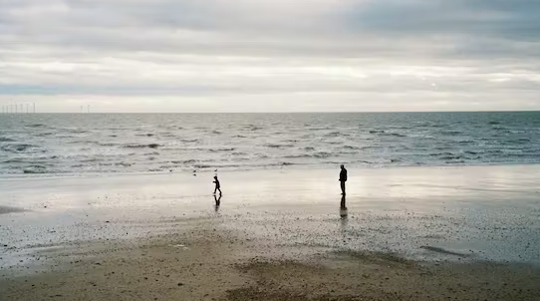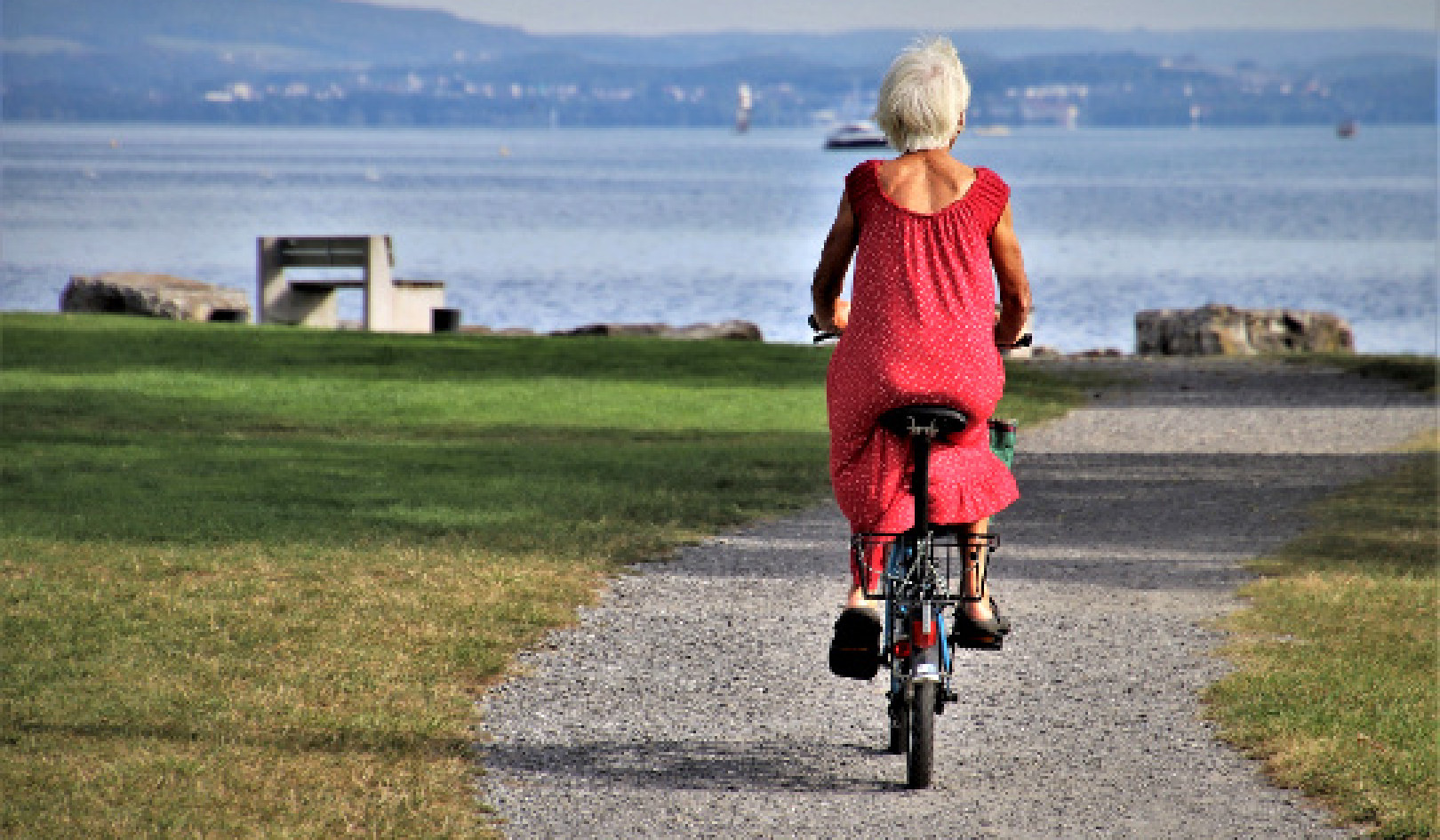
The right kind of blue. Nick Page/Unsplash, CC BY-SA
Dreary weather, freezing temperatures, long dark days, no festivities to look forward to – it’s beginning to feel at lot like the middle of January. The idea that there is a “Blue Monday” somewhere around the middle of the month where people feel most miserable may be a bit of a myth, but seasonal affective disorder is real enough. No wonder many people take off at this time of year in search of winter sun.
To lift your mood, however, you don’t need to go as far as that. Plenty of us go for winter walks near nature, and for many that can mean a trip to the local coast. The health benefits of spending time near the seaside are increasingly well documented, including making people feel happier and more relaxed.
A good number of people even move to the coast in the belief that they will enjoy these benefits all the time. This may well be mentally beneficial, yet it has become clear to researchers that those who visit the seaside for leisure get more out of it. Our latest research helps to explain why.
Oh I do like to…
Visiting the seaside for its perceived health benefits is hardly a new phenomenon. As far back as the mid-18th century, city dwellers sought out places offering cleaner air and the rhythms of nature.
As industrialisation progressed during the 19th century, the desire to visit the coast stemmed as much from a need to escape polluted, overcrowded cities as a desire to be near the sea. This was when the modern idea of the seaside was essentially “invented”, and English coastal towns like Blackpool, Skegness and Scarborough began to boom.
These days, of course, the sticks of rock and donkey rides have mostly been swapped for those more exotic locations. We are more likely to go to the local coast for a few hours away from the stresses of modern life in some beautiful scenery.
On the question of why this might be more beneficial than living at the coast, one suggested possibility is that visitors are in more of a “leisure state of mind”. They are more open and sensitive to the health-giving properties of coastal areas because they have time to savour the moment and become attuned to the seaside. If so, this might amplify any health benefits.
Our research
To test this idea, we surveyed 333 people at five seaside locations in Lancashire in north-west England (Lytham St Annes, Blackpool, Cleveleys, Fleetwood and Morecambe). We gauged their sense of wellbeing by asking them eight questions, including whether they felt better when looking out at the sea, more relaxed in this environment, and had happy memories of being at the seaside.
Respondents had to score each question out of 4, with 0 being no benefit and 4 being the highest benefit, allowing for a maximum “Seaside Wellbeing Index” (or SWI) score of 32. We conducted our surveys in the summertime, but the findings are likely to be applicable the year round.
Most respondents displayed relatively high scores, which was unsurprising, since we know the seaside helps people to relax and feel well. We split respondents into two broad groups, those at work and those at leisure. The people we surveyed were either working at the time they were surveyed, or there for leisure purposes (walking or sitting near the sea). Occupations of the workers ranged from coach driver to chef to nurse.
Of those at leisure, we broke them down into three further sub-groups: overnight visitors, day visitors and local residents. Visitors displayed higher scores than local residents. Those who scored highest were visitors staying overnight (an average SWI score of 27.2 compared to 25.9 for local residents, with day visitors actually slightly lower at 25.6). This suggests that the longer you stay away from home, the more relaxed and leisurely you become.
People who were working scored lower on average than those at leisure. The average SWI scores were 22.4 for workers, 26.2 for those at leisure, a statistically significant difference of 3.8.
This might mean that working people value the seaside environment less. Interestingly, however, our research also indicates that 70% of seaside workers would rather work by the sea than inland. This takes us back to the idea that while visitors might benefit most from being at the seaside, everyone benefits to some extent. It’s also worth noting there was a subtle difference in average SWI scores for people living away from the sea (25.8) and those living nearby (24.6).
Implications
Being at leisure gives individuals time not just to see but to properly soak up the seaside environment. This is why it is the perfect antidote to being confined in cities and the stresses of everyday life. In January, as we look towards the long year ahead, leisure time can therefore be well spent at the coast. Those marketing seaside destinations and managing the visitor experience would do well to highlight the need for visitors to slow down and savour the seaside environment.
There are also implications for doctors. Over the past decade, there is evidence that even the most cynical within the medical community are accepting the benefits that natural environments can have on health and well-being. As part of this, it’s clearly worth encouraging people to get away from their lives for a day or two and take time at the seaside.
So if you’re looking for something to do in the depths of January, walking on beaches is not just a way of killing time. It’s a form of medicine. So why not get your coat on and head for the seaside – a couple of windswept hours might make all the difference.![]()
About The Authors
Nick Davies, Lecturer and Programme Leader, BA International Tourism and Events Management, Glasgow Caledonian University and Sean J Gammon, Reader in Leisure and Tourism Management, University of Central Lancashire
This article is republished from The Conversation under a Creative Commons license. Read the original article.

Books Improving Attitude and Behavior from Amazon's Best Sellers list
"Atomic Habits: An Easy & Proven Way to Build Good Habits & Break Bad Ones"
by James Clear
In this book, James Clear presents a comprehensive guide to building good habits and breaking bad ones. The book includes practical advice and strategies for creating lasting behavior change, based on the latest research in psychology and neuroscience.
Click for more info or to order
"Unf*ck Your Brain: Using Science to Get Over Anxiety, Depression, Anger, Freak-Outs, and Triggers"
by Faith G. Harper, PhD, LPC-S, ACS, ACN
In this book, Dr. Faith Harper offers a guide to understanding and managing common emotional and behavioral issues, including anxiety, depression, and anger. The book includes information on the science behind these issues, as well as practical advice and exercises for coping and healing.
Click for more info or to order
"The Power of Habit: Why We Do What We Do in Life and Business"
by Charles Duhigg
In this book, Charles Duhigg explores the science of habit formation and how habits impact our lives, both personally and professionally. The book includes stories of individuals and organizations who have successfully changed their habits, as well as practical advice for creating lasting behavior change.
Click for more info or to order
"Tiny Habits: The Small Changes That Change Everything"
by BJ Fogg
In this book, BJ Fogg presents a guide to creating lasting behavior change through small, incremental habits. The book includes practical advice and strategies for identifying and implementing tiny habits that can lead to big changes over time.
Click for more info or to order
"The 5 AM Club: Own Your Morning, Elevate Your Life"
by Robin Sharma
In this book, Robin Sharma presents a guide to maximizing your productivity and potential by starting your day early. The book includes practical advice and strategies for creating a morning routine that supports your goals and values, as well as inspiring stories of individuals who have transformed their lives through early rising.
Click for more info or to order






















